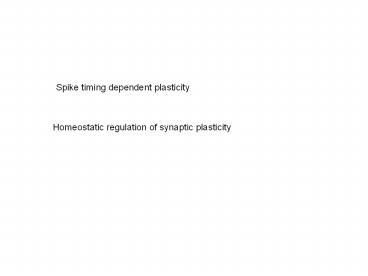Spike timing dependent plasticity - PowerPoint PPT Presentation
1 / 26
Title:
Spike timing dependent plasticity
Description:
NMDAR activation determines the polarity and magnitude of plasticity ... If A then B, then potentiate. Long-term potentiation. LTP. Stent's postulate: ... – PowerPoint PPT presentation
Number of Views:377
Avg rating:3.0/5.0
Title: Spike timing dependent plasticity
1
Spike timing dependent plasticity
Homeostatic regulation of synaptic plasticity
2
Current model of LTP and LTD
NMDA receptor
Synaptic protein
Synaptic protein-PO3
LTP
LTD
Postsynaptic membrane
3
NMDAR activation determines the polarity and
magnitude of plasticity Selective induction of
LTP or LTD by targeting NMDAR activation
Pairing paradigms
Patterned stimulation
Synaptic change ()
Stimulation frequency
Vm during pairing (mV)
4
Theory plasticity linked to the correlation of
activity
Neurons that fire out of sync lose their link.
5
Action potentials back-propagate into the
dendrites
Stuart Sakmann
6
Differences between active and passive dendrites
7
Induction of LTP by pairing action potentials
with synaptic activation
Action potentials
Synaptic stimulation
Action potentials
Synaptic stimulation
8
Back-propagating action potential helps Ca
entry During synaptic activation
Ca2 signal
Voltage signal
Dendritic recording
Stimulation
Somatic recording
Magee Johnston
9
Back-propagation of action potential is
essential for the induction of LTP
Ca2 signal
Voltage signal
Synaptic stimulation
TTX
Action potentials generated in the soma
10
Two-Photon Ca-imaging reveals supralinear
interactions between AP and synaptic activation
11
Supra-linear interactions requires A precise
timing
12
Basic Rules and Mechanisms of Synaptic
Plasticity Spike Timing-Dependent plasticity STDP
A
B
A
B
A
B
Stents postulate If B then A, then
depress Long-term depression LTD
Hebbs postulate If A then B, then
potentiate Long-term potentiation LTP
13
Example of Hebbian and anti-Hebbian plasticity
in cortex
Pre then post-gt Long term potentiation (LTP)
Post then pre-gt Long term depression (LTD)
Time (10 min)
14
Spike timing dependent plasticity (STDP) Timing
codes for polarity and magnitude of plasticity
Feldman Neuron 27, 45
Bi and Poo JNS 18 10464
15
Hallmarks of Spike timing dependent plasticity
(STDP) -Timing codes for polarity and magnitude
of plasticity -Strictly based on temporal
correlations, not on the levels of
activity. -Rules that encode causality pre
then post-gtLTP post then pre-gt LTD -Synaptic
changes could be computed from spike
trains -Fullfils the letter of the Hebbian and
anti-Hebbiean rules
16
- How Timing codes for the polarity of plasticity?
- pre then post-gtLTP easy, the AP boosts the
activation of the NMDAR by reducing the Mg block - post then pre-gt LTD several hypothesis
- Ca entry during the AP. Ca is not fully removed
by the time synapses are activated and help to
bring Cai to the LTD threshold - Ca entry during the AP desensitizes the NMDAR so
it does no reach the threshold for LTP.
(contradicts 1) - 3) Ca entry during the AP favours the production
of endocannabinoids, which in turn reduces
presynaptic release (LTD and LTP do not reverse
each other)
17
Need for the regulation of synaptic plasticity
Networks built with LTP and LTD only tend to be
bistable Neural activity and LTP/LTD can enter
in a vicious circle
LTP
LTD
18
(No Transcript)
19
Experimental results in visual cortex require
additional explanation
Classical experiments of monocular
deprivation Cells in the visual cortex tend to
be binocular and respond to stimulation in both
eyes, with different preferences,
though. Closing the eye for a brief period
causes a shift in the responses towards the
non-deprived eye. These shifts in ocular
dominance can be easely interpreted as resulting
from LTP/D like mechanisms
of reponsive cells
Right eye Left eye
of reponsive cells
Right eye Left eye
20
Reverse suture experiments
LTP of left inputs?
Sliding threshold Synaptic scaling
21
Sliding threshold the BCM model (Bienenstock,
Cooper, Munroe)
Wsynaptic weight Pre presynaptic
activity Post postsynaptic activity F
modification threshold
DWF(PrePost-f)
22
- depends on previous activity
- The threshold for LTP decreases when postsynaptic
activity is low
F slides to a lower level and then LTP of left
inputs happens
Evidence It is easier to obtain LTP in the
cortex of dark-reared animals and it is harder to
induced LTD in these cortices
23
Synaptic scaling
24
Low firing rates Increase synaptic drive
High firing rates Reduce synaptic drive
By scaling up or down all synapses, the cell
keeps constant the level of excitation while it
preserve the relative strength of the synapses.
It maintains activity without disturbing
memories
25
Previously in TTX
Previously in Biccuculine
Note that S2/S1remain constant
Not shown Scaling does not depend on NMDARs
Evidence spontaneous minis are larger in
deprived cortex
26
Synaptic scaling
Sliding threshold
Global affects all synapses
Global affects all synapses
Dark rearing reduces threshold for LTP in visual
cortex
Dark rearing increases the size of the unitary
responses in visual cortex
Does not affect stored memories
Does not affect stored memories































